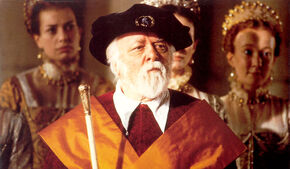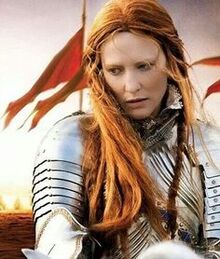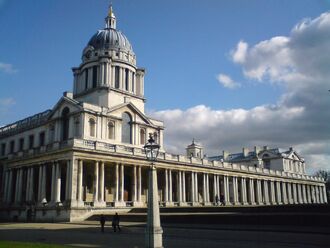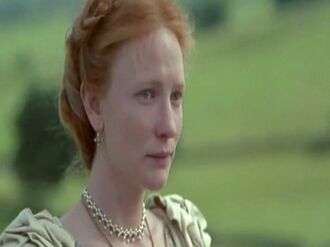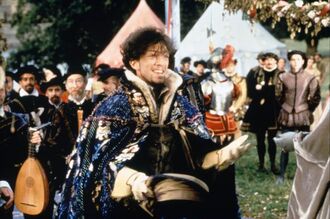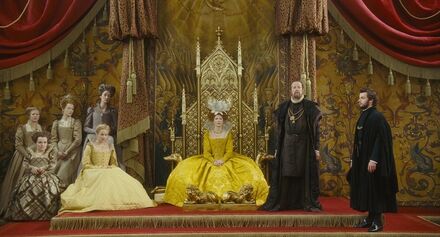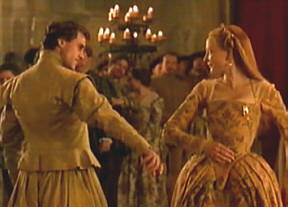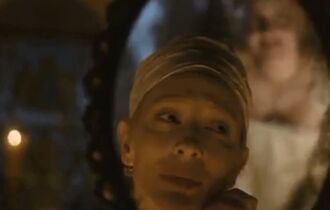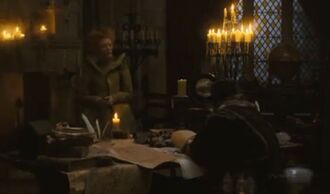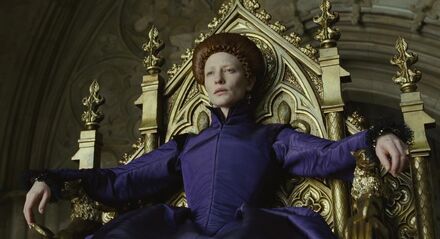
Queen Elizabeth I of England played by Cate Blanchett in "Elizabeth: The Golden Age".
Queen Elizabeth I of England is the main character of the historical movie saga "Elizabeth" of film director Shekhar Kapur. The character is based on the real regent of England and Ireland from 1558 to 1603.
Elizabeth I (7 September 1533 – 24 March 1603) was Queen of England and Ireland from 17 November 1558 until her death. Sometimes called The Virgin Queen, Gloriana or Good Queen Bess, the childless Elizabeth was the fifth and last monarch of the Tudor dynasty.
Elizabeth was the daughter of King Henry VIII and his second wife, Anne Boleyn.

Elizabeth's half brother, King Edward VI, ruled England for a very short period of time until his death at 15 years old.
Anne Boleyn was executed by the King Henry VIII when Elizabeth was two and a half years. Anne's marriage to Henry VIII was annulled, and Elizabeth was declared illegitimate.
Her half-brother, Edward VI, ruled until his death in 1553, bequeathing the crown to Lady Jane Grey and ignoring the claims of his two half-sisters, Elizabeth and the Roman Catholic Mary, in spite of statute law to the contrary. However, Edward's will was set aside and Mary became queen, deposing Lady Jane Grey. During Mary's reign, Elizabeth was imprisoned for nearly a year on suspicion of supporting Protestant rebels.
In 1558, Elizabeth succeeded her half-sister to the throne, and she set out to rule by good counsel. She depended heavily on a group of trusted advisers, led by William Cecil, Baron Burghley.
One of her first actions as queen was the establishment of an English Protestant church, of which she became the Supreme Governor. This Elizabethan Religious Settlement later evolved into today's Church of England.
It was expected that Elizabeth would marry and produce an heir to continue the Tudor line. She never did, despite numerous courtships. As she grew older, Elizabeth became famous for her virginity. A cult grew up around her which was celebrated in the portraits, pageants, and literature of the day.
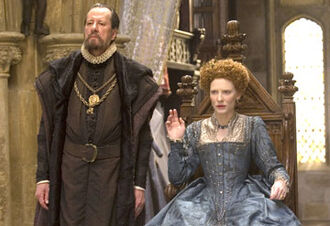
The plots to dethrone Elizabeth I were all defeated thanks mainly to one of her must trusted advisor and spymaster, Sir Francis Walsingham.
In government, Elizabeth was more moderate than her father and half-siblings had been. One of her mottoes was "video et taceo" ("I see, and say nothing"). In religion she was relatively tolerant, avoiding systematic persecution.
After 1570, when the pope declared her illegitimate and released her subjects from obedience to her, several conspiracies threatened her life. All plots were defeated, however, with the help of her ministers' secret service.
Elizabeth was cautious in foreign affairs, manoeuvring between the major powers of France and Spain. She only half-heartedly supported a number of ineffective, poorly-resourced military campaigns in the Netherlands, France, and Ireland. However, by the mid-1580s, war with Spain could no longer be avoided. When Spain finally decided to attempt to conquer England in 1588, the failure of the Spanish Armada associated her with one of the greatest military victories in English history.
Elizabeth's reign is known as the Elizabethan era. The period is famous for the flourishing of English drama, led by playwrights such as William Shakespeare and Christopher Marlowe, and for the seafaring prowess of English adventurers such as Francis Drake.
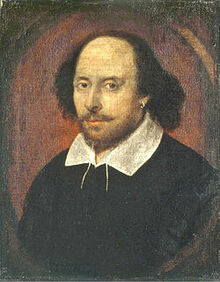
A portrait of William Shakespeare, the most famous and afamed playwrighter of the Elizabeth I's era.

A portrait of Queen Elizabeth I at her late years.
Some historians are more reserved in their assessment. They depict Elizabeth as a short-tempered, sometimes indecisive ruler, who enjoyed more than her of luck. Towards the end of her reign, a series of economic and military problems weakened her popularity.
Elizabeth is acknowledged as a charismatic performer and a dogged survivor in an era when government was ramshackle and limited, and when monarchs in neighbouring countries faced internal problems that jeopardised their thrones. Such was the case with Elizabeth's rival, Mary, Queen of Scots, whom she imprisoned in 1568 and eventually had executed in 1587.
After the short reigns of Elizabeth's half-siblings, her 44 years on the throne provided welcome stability for the kingdom and helped forge a sense of national identity.
Early life[]
Elizabeth was born at Greenwich Palace and was named after both her grandmothers, Elizabeth of York and Elizabeth Howard. She was the second child of Henry VIII of England born in wedlock to survive infancy. Her mother was Henry's second wife, Anne Boleyn.
At birth, Elizabeth was the heiress presumptive to the throne of England. Her older half-sister, Mary, had lost her position as a legitimate heir when Henry annulled his marriage to Mary's mother, Catherine of Aragon, to marry Anne and sire a male heir to ensure the Tudor succession.
Elizabeth was baptised on 10 September; Archbishop Thomas Cranmer, the Marquess of Exeter, the Duchess of Norfolk and the Dowager Marchioness of Dorset stood as her godparents.
When Elizabeth was two years and eight months old, her mother was executed on 19 May 1536 by her father, King Henry VIII, orders. Elizabeth was declared illegitimate and deprived of her place in the royal succession. Eleven days after Anne Boleyn's death, Henry married Jane Seymour, but she died shortly after the birth of their son, Prince Edward, in 1537. From his birth, Edward was undisputed heir apparent to the throne.
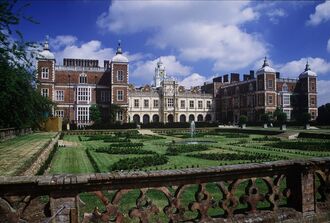
Elizabeth lived her childhood at Hatfield House, in Hertfordshire, under the household of her father King Henry VIII and her brother King Edward VI.
Elizabeth was placed in Prince Edward's household and carried the chrisom, or baptismal cloth, at his christening.
Elizabeth's first governess or Lady Mistress, Margaret Bryan, wrote that she was "as toward a child and as gentle of conditions as ever I knew any in my life". By the autumn of 1537, Elizabeth was in the care of Blanche Herbert, Lady Troy, who remained her Lady Mistress until her retirement in late 1545 or early 1546.
Catherine Champernowne, better known by her later, married name of Catherine "Kat" Ashley, was appointed as Elizabeth's governess in 1537, and she remained Elizabeth's friend until her death in 1565, when Blanche Parry succeeded her as Chief Gentlewoman of the Privy Chamber. Champernowne taught Elizabeth four languages: French, Flemish, Italian and Spanish. By the time William Grindal became her tutor in 1544, 11 years old Elizabeth could write English, Latin, and Italian. Under Grindal, a talented and skilful tutor, she also progressed in French and Greek.
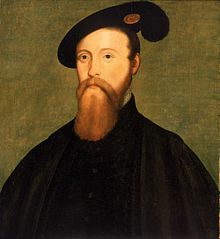
Thomas Seymour, Elizabeht's stepfather, who allegedly abused Elizabeth when she was a teenager. Seymour was sentenced to death in 1949 for treason and was beheaded.
In 1547 King Henry VIII died and Elizabeth's half-brother, Edward VI, became king at age nine.Catherine Parr, King Henry's widow, soon married Thomas Seymour of Sudeley, Edward VI's uncle and the brother of the Lord Protector,Edward Seymour, Duke of Somerset. The couple took Elizabeth into their household at Chelsea. There Elizabeth experienced an emotional crisis that some historians believe affected her for the rest of her life. Seymour, approaching age 40 but having charm and "a powerful sex appeal", engaged in romps and horseplay with the 14-year-old Elizabeth. These included entering her bedroom in his nightgown, tickling her and slapping her on the buttocks. Parr, rather than confront her husband over his inappropriate activities, joined in. Twice she accompanied him in tickling Elizabeth, and once held her while he cut her black gown "into a thousand pieces."However, after Parr discovered the pair in an embrace, she ended this state of affairs. In May 1548, Elizabeth was sent away.
In 1548, Elizabeth received her education under Roger Ascham, a sympathetic teacher who believed that learning should be engaging. When Parr died after childbirth on 5 September 1548, Thomas Seymour renewed his attentions towards Elizabeth, intent on marrying her. The details of his former behaviour towards Elizabeth emerged, and for his brother and the council, this was the last straw.
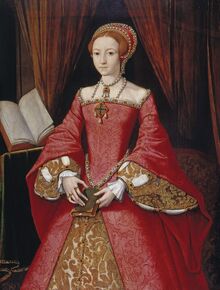
Portrait of Lady Elizabeth at the age of 15, by the time she was a Princess.
In January 1549, Seymour was arrested on suspicion of plotting to marry Elizabeth and overthrow Edward VI. Elizabeth, living at Hatfield House, would admit nothing. Her stubbornness exasperated her interrogator, Sir Robert Tyrwhitt, who reported, "I do see it in her face that she is guilty".Seymour was beheaded on 20 March 1549. The month Seymour was senteced to death for treason and was behaded.
By the time her formal education ended in 1550, 17 years old Elizabeth was one of the best educated women of her generation. By the end of her life, Elizabeth was also reputed to speak Welsh, Cornish, Scottish and Irish in addition to English. The Venetian ambassador stated in 1603 that she "possessed [these] languages so thoroughly that each appeared to be her native tongue". Historian Mark Stoyle suggests that she was probably taught Cornish by William Killigrew, Groom of the Privy Chamber and later Chamberlain of the Exchequer.
Mary I's reign[]
Edward VI died on 6 July 1553, aged 15. His will swept aside the Succession to the Crown Act 1543, excluded both Mary and Elizabeth from the succession, and instead declared as his heir Lady Jane Grey, granddaughter of Henry VIII's sister Mary, Duchess of Suffolk. Lady Jane was proclaimed queen by the Privy Council, but her support quickly crumbled, and she was deposed after nine days. On 3 August 1553, Mary rode triumphantly into London, with Elizabeth at her side.
The show of solidarity between the sisters did not last long. Mary, a devout Catholic, was determined to crush the Protestant faith in which Elizabeth had been educated, and she ordered that everyone attend Catholic Mass; Elizabeth had to outwardly conform. Mary's initial popularity ebbed away in 1554 when she announced plans to marry Prince Philip of Spain, the son of Emperor Charles V and an active Catholic. Discontent spread rapidly through the country, and many looked to Elizabeth as a focus for their opposition to Mary's religious policies.

In 1554 Elizabeth was imprisoned at the Tower of London accussed of plotting against her sister Queen Mary.
In January and February 1554, Wyatt's rebellion broke out; it was soon suppressed. Elizabeth was brought to court, and interrogated regarding her role, and on 18 March, she was imprisoned in the Tower of London. Elizabeth fervently protested her innocence. Though it is unlikely that she had plotted with the rebels, some of them were known to have approached her. Mary's closest confidant, Charles V's ambassador Simon Renard, argued that her throne would never be safe while Elizabeth lived; and the Chancellor, Stephen Gardiner, worked to have Elizabeth put on trial. Elizabeth's supporters in the government, including Lord Paget, convinced Mary to spare her sister in the absence of hard evidence against her. Instead, on 22 May, Elizabeth was moved from the Tower to Woodstock, where she was to spend almost a year under house arrest in the charge of Sir Henry Bedingfield. Crowds cheered her all along the way.
On 17 April 1555, Elizabeth was recalled to court to attend the final stages of Mary's apparent pregnancy. If Mary and her child died, Elizabeth would become queen. If, on the other hand, Mary gave birth to a healthy child, Elizabeth's chances of becoming queen would recede sharply. When it became clear that Mary was not pregnant, no one believed any longer that she could have a child. Elizabeth's succession seemed assured.

Before the death of her sister, Queen Mary. Elizabeth was already in talks with Sir William Cecil about her future strategies as regent Queen.
King Philip, who ascended the Spanish throne in 1556, acknowledged the new political reality and cultivated his sister-in-law. She was a better ally than the chief alternative, Mary, Queen of Scots, who had grown up in France and was betrothed to the Dauphin of France. When his wife fell ill in 1558, King Philip sent the Count of Feria to consult with Elizabeth. This interview was conducted at Hatfield House, where she had returned to live in October 1555. By October 1558, Elizabeth was already making plans for her government. On 6 November, Mary recognised Elizabeth as her heir. On 17 November 1558, Mary died and Elizabeth succeeded to the throne.
Elizabeth's accession and reign.[]
Elizabeth became in late 1558, queen at the age of 25, and declared her intentions to her Council and other peers who had come to Hatfield to gave her the news to swear allegiance to her.
The speech contains the first record of her adoption of the mediaeval political theology of the sovereign's "two bodies": the body natural and the body politic.
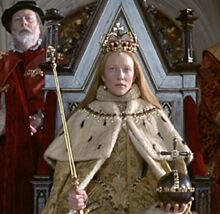
Elizabeth was crowned at Westminster Abby.
As her triumphal progress wound through the city on the eve of the coronation ceremony, she was welcomed wholeheartedly by the citizens and greeted by orations and pageants, most with a strong Protestant flavour. Elizabeth's open and gracious responses endeared her to the spectators, who were "wonderfully ravished". The following day, 15 January 1559, Elizabeth was crowned and anointed by Owen Oglethorpe, the Catholic bishop of Carlisle, in Westminster Abbey. She was then presented for the people's acceptance, amidst a deafening noise of organs, fifes, trumpets, drums, and bells.
From the start of Elizabeth's reign, it was expected that she would marry and the question arose to whom. She never did, although she received many offers for her hand; the reasons for this are not clear. Historians have speculated that Thomas Seymour had put her off sexual relationships, or that she knew herself to be infertile. She considered several suitors until she was about fifty.
In the spring of 1559, it became evident that Elizabeth was in love with her childhood friend Robert Dudley. It was said that Amy Robsart, Robert Dudley's wife, was suffering from a "malady in one of her breasts", and that the Queen would like to marry Dudley if his wife should die.
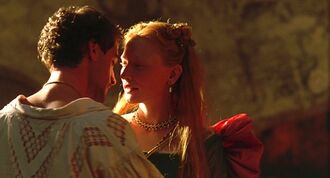
Robert Dudley was Elizabeth's friend since they were both children, and for the Court it became evident they were in love during Elizabeth's reign.
By the autumn of 1559 several foreign suitors were vying for Elizabeth's hand; their impatient envoys engaged in ever more scandalous talk and reported that a marriage with her favourite was not welcome in England: "There is not a man who does not cry out on him and her with indignation ... she will marry none but the
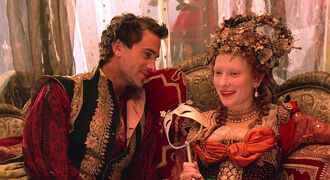
During Elizabeth's reing, Robert Dudley and Queen Elizabeth I never hid their flirtations with eachother at court
favoured Robert". Amy Dudley died in September 1560 from a fall from a flight of stairs and, despite the coroner's inquest finding of accident, many people suspected Dudley to have arranged her death so that he could marry the queen. Elizabeth seriously considered marrying Dudley for some time. However, William Cecil, Nicholas Throckmorton, and some conservative peers made their disapproval unmistakably clear. There were even rumours that the nobility would rise if the marriage took place. Among other marriages being considered for the queen, Robert Dudley was regarded as a possible candidate for nearly another decade. Elizabeth was extremely jealous of his affections, even when she no longer meant to marry him herself.
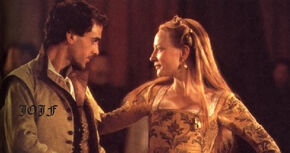
Even if the court presented her with some political suitor for her marriage, Queen Elizabeth I continued her flirtatious attitude towards Robert Dudley during her reign.
Marriage negotiations constituted a key element in Elizabeth's foreign policy. She turned down Philip II's own hand early in 1559 but for several years entertained the proposal of King Eric XIV of Sweden. For several years she also seriously negotiated to marry Philip II's cousin Archduke Charles of Austria. By 1569, relations with the Habsburgs had deteriorated, and Elizabeth considered marriage to two French Valois princes in turn, first Henry, Duke of Anjou, and later, from 1572 to 1581, his brother Francis, Duke of Anjou, formerly Duke of Alençon. This last proposal was tied to a planned alliance against Spanish control of the Southern Netherlands. Elizabeth seems to have taken the courtship seriously for a time, and wore a frog-shaped earring that Anjou had sent her.
The succession question became a heated issue in Parliament. They urged the queen to marry or nominate an heir, to prevent a civil war upon her death. She refused to do either. By 1570, senior figures in the government privately accepted that Elizabeth would never marry or name a successor (she knew that if she named an heir, her throne would be vulnerable to a coup; she remembered that the way "a second person, as I have been" had been used as the focus of plots against her predecessor).
Elizabeth's unmarried status inspired a cult of virginity. In poetry and portraiture, she was depicted as a virgin or a goddess or both, not as a normal woman. And, putting a positive spin on her marital status, Elizabeth insisted she was married to her kingdom and subjects, under divine protection. In 1599, she spoke of "all my husbands, my good people".
During the firs steps of her reign, a Church settlement was crucial for the stability of the country. In terms of public policy Elizabeth favoured pragmatism in dealing with religious matters, while she kept her religious convictions very private. Her religious convictions have been of much debate by scholars; she was a Protestant but kept Catholic symbols (such as the crucifix), and downplayed the role of sermons in defiance of a key Protestant belief.
Elizabeth and her advisers perceived the threat of a Catholic crusade against heretical England, so Elizabeth therefore sought a Protestant solution that would not offend Catholics too greatly while addressing the desires of English Protestants; she would not tolerate the more radical Puritans though, who were pushing for far-reaching reforms.
As a result, the parliament of 1559 started to legislate for a church based on the Protestant settlement of Edward VI, with the monarch as its head, but with many Catholic elements, such as priestly vestments. The House of Commons backed the proposals strongly, but the bill of supremacy met opposition in the House of
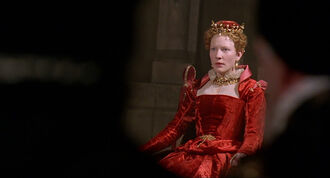
At the House of Lord, Elizabeth found some opossition to pass the Act of Uniformity of the English Chruch, but her speech at the chamber cleared up the undecided ones.
Lords, particularly from the bishops. Elizabeth was fortunate that many bishoprics were vacant at the time, including the Archbishopric of Canterbury. This enabled supporters amongst peers to outvote the bishops and conservative peers. Nevertheless, Elizabeth was forced to accept the title of Supreme Governor of the Church of England rather than the more contentious title of Supreme Head, which many thought unacceptable for a woman to bear.
The new Act of Supremacy became law on 8 May 1559. All public officials were to swear an oath of loyalty to the monarch as the supreme governor or risk disqualification from office; the heresy laws were repealed, to avoid a repeat of the persecution of dissenters practised by her predecesor Queen Mary. At the same time, a new Act of Uniformity was passed, which made attendance at church and the use of an adapted version of the 1552 Book of Common Prayer compulsory, though the penalties for recusancy, or failure to attend and conform, were not.
Another big threat Elizabeth had to face during her reign was the opposition she faced from Mary, Queen of Scots (who was considered by many catholicts to be the legitimate heir to the English crown) and her french allies. Elizabeth feared that the French planned to invade England and put Mary, Queen of Scots, on the throne.

The Council persuaded Elizabeth I to send some troops to Scotland to fight against Mary's forces.
Elizabeth was persuaded by her council to send a force into Scotland to aid the Protestant rebels there, and though the campaign was inept, the resulting Treaty of Edinburgh of July 1560 removed the French threat in the north. When Mary returned to Scotland in 1561 to take up the reins of power, the country had an established Protestant church and was run by a council of Protestant nobles supported by Elizabeth. Mary refused to ratify the treaty.
In 1565 Mary married Henry Stuart, Lord Darnley, who carried his own claim to the English throne. The marriage was the first of a series of errors of judgement by Mary that handed the victory to the Scottish Protestants and to Elizabeth. Darnley quickly became unpopular in Scotland and then infamous for presiding over the murder of Mary's Italian secretary David Rizzio. In February 1567, Darnley was murdered by conspirators almost certainly led by James Hepburn, Earl of Bothwell. Shortly afterwards, on 15 May 1567, Mary married Bothwell, arousing suspicions that she had been party to the murder of her husband. These events led rapidly to Mary's defeat and imprisonment in Loch Leven Castle at Scotland. The Scottish lords forced her to abdicate in favour of her son James, who had been born in June 1566. James was taken to Stirling Castle to be raised as a Protestant. Mary escaped from Loch Leven in 1568 but after another defeat fled across the border into
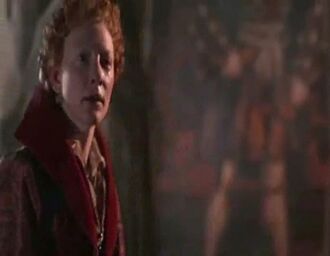
Elizabeth I at first didn't know how to deal with the plots made by catholic groups from Scotland and France against her, and didn't know how to deal with Mary, Queen of Scots.
England, where she had once been assured of support from Elizabeth. Elizabeth's first instinct was to restore her fellow monarch; but she and her council instead chose to play safe. Rather than risk returning Mary to Scotland with an English army or sending her to France and the Catholic enemies of England, they detained her in England, where she was imprisoned for the next nineteen years.
Mary was soon the focus for rebellion. In 1569 there was a major Catholic rising in the North; the goal was to free Mary, marry her to Thomas Howard, 4th Duke of Norfolk, and put her on the English throne. After the rebels' defeat, over 750 of them were executed on Elizabeth's orders.
In the belief that the revolt had been successful, Pope Pius V issued a bull in 1570, titled Regnans in Excelsis, which declared "Elizabeth, the pretended Queen of England and the servant of crime" to be excommunicate and a heretic, releasing all her subjects from any allegiance to her. Catholics who obeyed her orders were threatened with excommunication.

The Council advises Elizabeth I to hang all catholics but she refuses. The Council also warns Elizabeth I of the threat that is Mary, Queen of Scots to the English throne.
The papal bull provoked legislative initiatives against Catholics by Parliament, which were however mitigated by Elizabeth's intervention. In 1581, to convert English subjects to Catholicism with "the intent" to withdraw them from their allegiance to Elizabeth was made a treasonable offence, carrying the death penalty. From the 1570s missionary priests from continental seminaries came to England secretly in the cause of the "reconversion of England". Many suffered execution, engendering a cult of martyrdom. Regnans in Excelsis gave English Catholics a strong incentive to look to Mary Stuart as the true sovereign of England.
Mary may not have been told of every Catholic plot to put her on the English throne, but from the Ridolfi Plot of 1571 (which caused Mary's suitor, the Duke of Norfolk, to lose his head) to the Babington Plot of 1586, Elizabeth's spymaster Sir Francis Walsingham and the royal council keenly assembled a case against her.
At first, Elizabeth resisted calls for Mary's death. By late 1586 she had been persuaded to sanction her trial
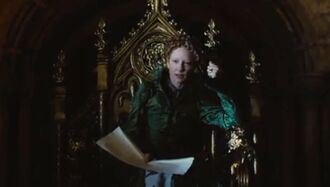
Elizabeth I resists at first to sign the death warrant for her cousin Mary, Queen of Scots.
and execution on the evidence of letters written during the Babington Plot. On 8 February 1587, Mary was beheaded at Fotheringhay Castle, Northamptonshire. After Mary's execution, Elizabeth claimed not to have ordered it and indeed most accounts have her telling Secretary Davidson, who brought her the warrant to sign, not to dispatch the warrant even though she had signed it. The sincerity of Elizabeth's remorse and her motives for telling Davidson not to execute the warrant have been called into question both by her contemporaries and later historians.
About England's foreign policy, Elizabeth I's was largely defensive. The exception was the English occupation of Le Havre from October 1562 to June 1563, which ended in failure when Elizabeth's Huguenot allies joined with the Catholics to retake the port. Elizabeth's intention had been to exchange Le Havre for Calais, lost to France in January 1558.
Only through the activities of her fleets did Elizabeth pursue an aggressive policy. This paid off in the war against Spain, 80% of which was fought at sea. She knighted Francis Drake after his circumnavigation of the globe from 1577 to 1580, and he won fame for his raids on Spanish ports and fleets. An element of piracy and self-enrichment drove Elizabethan seafarers, over which the queen had little control. Because of that, in 1586 Philip II of Spain decided to take the war to England.
In 1587 Sir Francis Drake had made a successful raid on Cadiz, destroying the Spanish fleet of war ships intended for the "Enterprise of England".

Elizabeth I host a military meeting to prepare the defense against the Spanish Armada at the English coast.
On 12 July 1588, the Spanish Armada, a great fleet of ships, set sail for the channel, planning to ferry a Spanish invasion force under the Duke of Parma to the coast of southeast England from the Netherlands. A combination of miscalculation, misfortune, and an attack of English fire ships on 29 July off Gravelines which dispersed the Spanish ships to the northeast defeated the Armada. The Armada straggled home to Spain in shattered remnants, after disastrous losses on the coast of Ireland (after some ships had tried to struggle back to Spain via the North Sea, and then back south past the west coast of Ireland). Unaware of the Armada's fate, English militias mustered to defend the country under the Earl of Leicester's command. He invited Elizabeth to

Elizabeth I gave her speech to the troops at Tilbury.
inspect her troops at Tilbury in Essex on 8 August. Wearing a silver breastplate over a white velvet dress, she addressed them in one of her most famous speeches: "My loving people, we have been persuaded by some that are careful of our safety, to take heed how we commit ourself to armed multitudes for fear of treachery; but I assure you, I do not desire to live to distrust my faithful and loving people ... I know I have the body but of a weak and feeble woman, but I have the heart and stomach of a king, and of a King of England too, and think foul scorn that Parma or Spain, or any Prince of Europe should dare to invade the borders of my realm".
When no invasion came, the nation rejoiced. Elizabeth's procession to a thanksgiving service at St Paul's Cathedral rivalled that of her coronation as a spectacle. The defeat of the armada was a potent propaganda victory, both for Elizabeth and for Protestant England. The English took their delivery as a symbol of God's favour and of the nation's inviolability under a virgin queen. However, the victory was not a turning point in the war, which continued and often favoured Spain. The Spanish still controlled the Netherlands, and the threat of invasion remained. Sir Walter Raleigh claimed after her death that Elizabeth's caution had impeded the war against Spain: "If the late queen would have believed her men of war as she did her scribes, we had in her time beaten that great empire in pieces and made their kings of figs and oranges as in old times. But her Majesty did all by halves, and by petty invasions taught the Spaniard how to defend himself, and to see his own weakness".
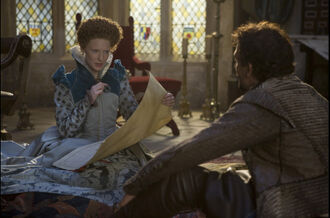
Elizabeth I discussing some overseas affairs with Sir Walter Raleigh, one of the most importants seamasters of the age.
Though some historians have criticised Elizabeth on similar grounds, Raleigh's verdict has more often been judged unfair. Elizabeth had good reason not to place too much trust in her commanders, who once in action tended, as she put it herself, "to be transported with an haviour of vainglory".
The period after the defeat of the Spanish Armada in 1588 brought new difficulties for Elizabeth that lasted the fifteen years until the end of her reign. The conflicts with Spain and in Ireland dragged on, the tax burden grew heavier, and the economy was hit by poor harvests and the cost of war. Prices rose and the standard of living fell. During this time, repression of Catholics intensified, and Elizabeth authorised commissions in 1591 to interrogate and monitor Catholic householders. To maintain the illusion of peace and prosperity, she
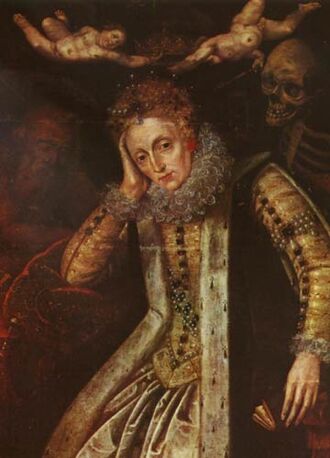
Elizabeth I, painted after 1620, during the first revival of interest in her reign. Time sleeps on her right and Death looks over her left shoulder.
increasingly relied on internal spies and propaganda. In her last years, mounting criticism reflected a decline in the public's affection for her.
This same period of economic and political uncertainty, however, produced an unsurpassed literary flowering in England. The first signs of a new literary movement had appeared at the end of the second decade of Elizabeth's reign, with John Lyly's Euphues and Edmund Spenser's The Shepheardes Calender in 1578. During the 1590s, some of the great names of English literature entered their maturity, including William Shakespeare and Christopher Marlowe.
Elizabeth's senior adviser, Burghley, died on 4 August 1598. His political mantle passed to his son, Robert Cecil, who soon became the leader of the government. One task he addressed was to prepare the way for a smooth succession. Since Elizabeth would never name her successor, Cecil was obliged to proceed in secret. He therefore entered into a coded negotiation with James VI of Scotland, who had a strong but unrecognised claim. Cecil coached the impatient James to humour Elizabeth.
The Queen's health remained fair until the autumn of 1602, when a series of deaths among her friends plunged her into a severe depression. In February 1603, the death of Catherine Howard, Countess of Nottingham, the niece of her cousin and close friend Catherine, Lady Knollys, came as a particular blow. In March, Elizabeth fell sick and remained in a "settled and unremovable melancholy". She died on 24 March 1603 at Richmond Palace, between two and three in the morning. A few hours later, Cecil and the council set their plans in motion and proclaimed James VI of Scotland as James I of England.
Elizabeth's coffin was carried downriver at night to Whitehall, on a barge lit with torches. At her funeral on 28
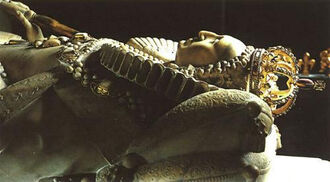
Elizabeth I's tomb at Westminster Abby
April, the coffin was taken to Westminster Abbey on a hearse drawn by four horses hung with black velvet. In the words of the chronicler John Stow:
Elizabeth was interred in Westminster Abbey in a tomb she shares with her half-sister, Mary. The Latin inscription on their tomb, "Regno consortes & urna, hic obdormimus Elizabetha et Maria sorores, in spe resurrectionis", translates to "Consorts in realm and tomb, here we sleep, Elizabeth and Mary, sisters, in hope of resurrection".
Personality[]

Elizabeth during one of her horse-rides with Sir Walter Raleigh.
Elizabeth was highly brisk; while she mastered the art of appearing stately and regal when it mattered, in private she moved and walked quickly. She loves to have long walks at her palaces and was an expert horsewoman, who loved to ride her horse at a gallop, frightening everyone (including Master of the Horse Robert Dudley) with her equestrian antics. Her obsession with dancing was famous, and she enjoyed watching dancers as much as she liked to dance herself.
She was also extremely proud, egocentric and conceited. She loved fine clothing and jewelry, and her attire was always the height of glamour and fashion in the period. She was fond of wearing wigs, especially as her hair grayed.
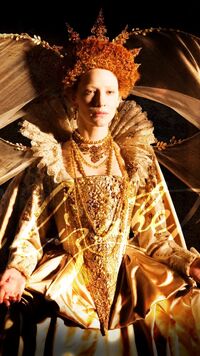
Elizabeth I loved to show off with extremelly flamboyant dresses, jewelry and trimming. And she got furious when some women dressed prettier clother than hers.
The Queen was not just for show, however. She had both natural talent and a willingness to study and
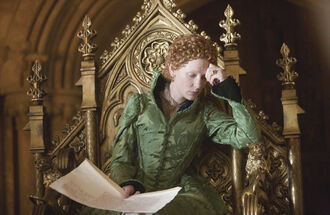
Elizabeth I discussing some political actions with one of her counselors, Francis Walshingham.
deliberate. She was an amazing polyglot and great strategist.
Always cautious in foreign affairs, she preferred in most cases to wait and see what happened, and decide what to do at the last moment. This patience often gave England an advantage over European nations led by more hotheaded rulers.
Elizabeth's fear of committing to action in foreign affairs, particularly her aversion to any and all war, was largely a product of her childhood, in which she had often witnessed the high costs of failure in politics.
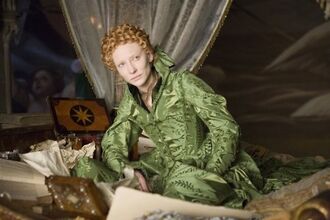
Elizabeth I usually struggled and doubted to take some important political decitions, such as to confirm a death warrant for her cousing Mary, Queen of Scots.
She was too extraordinarily stingy for a woman so wealthy, she believed wars expensive, and peace cheap.
Elizabeth was similarly guarded on issues of religion, always preferring compromise to definitive actions. Thus although she wished the English clergy to be celibate, because she knew this went against the Protestant view she did not challenge the English clergy's practice of marrying. Regarding communion and the great Protestant-Catholic spiritual debates of the Reformation, over which so many people were killing each other, Elizabeth refrained from comment, saying, "Some think one thing, some another, and only God can say whose judgment is best."
She was a devout protestant but also believed in astrology.
She hated bad smells and looks. And It is often reported that in her old age, Elizabeth became spiteful and treated married women with cruelty; although the truth of this is contested, one can certainly speculate that Elizabeth did not like it when the men she was trying to manipulate married other women instead; perhaps she did bear ill will against these women.

